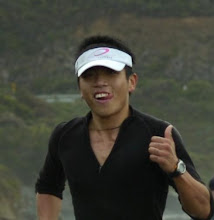Tuesday, May 01, 2007
More thoughts on navigation and dealing with errors...
I've given a lot more thought to navigation technique now - having done the rogaine over the weekend. Comparing it with the Google airphotos i used for the SAC, i would say that there are several key adjustments one has to make when using airphotos for navigation.
1. Shortcuts may not really be the best. When you can't make out steepness, or the existence of through-roads, or the presence of water bodies... it is usually best to stick to the biggest, fattest road you can see on the photo.
2. Slow is smooth, smooth is fast. This actually applies to all styles of navigation and strategy along a race course. Do not get caught up trying to speed through everything , because you will just increase the risk of losing track of where you are on the map.
3. Catching and guiding features.
For airphotos:
- Different coloured roofs / structures
- Changes in road texture / colour
- Bends and width variations in roads
- Vegetation colour interfaces
For topo maps:
- Gullies and spurs, no matter how insignificant
- Obvious slopes (change in contour spacing)
- Surrounding slope profiles, encompassing a 360 view of the terrain (this is different from obvious slopes, which may be off to one side only)
- Vegetation density changes
- Man-made features marked on the map
As someone who is preparing to take on a leadership role on an AR team, navigation is one of those aspects where 'inspiring confidence' is a key tenet.
One has to be strong for a start - in order to operate at an efficient enough level such that navigational awareness and mental acuity are not compromised.
One then also has to be willing to accept responsibility for guiding the team through the course. It is not a light responsibility, but boy is it one of the most rewarding!
Delegation of navigation-specific tasks must be undertaken - firmly and with an eye one making sure everyone is aware of 'the plan' - to make lessen the burden of this sometimes-overwhelming responsibility. Asking for help is to be respected, not ridiculed.
Finally, be assertive with your calls - so that even when in doubt, you and your team do not stuff around unnecessarily out on the course. It is easier to make notes, plot bearings, and measure distances accurately in a controlled environment rather than out in the wilderness. Remember, proper planning prevents piss poor performance!
1. Shortcuts may not really be the best. When you can't make out steepness, or the existence of through-roads, or the presence of water bodies... it is usually best to stick to the biggest, fattest road you can see on the photo.
2. Slow is smooth, smooth is fast. This actually applies to all styles of navigation and strategy along a race course. Do not get caught up trying to speed through everything , because you will just increase the risk of losing track of where you are on the map.
3. Catching and guiding features.
For airphotos:
- Different coloured roofs / structures
- Changes in road texture / colour
- Bends and width variations in roads
- Vegetation colour interfaces
For topo maps:
- Gullies and spurs, no matter how insignificant
- Obvious slopes (change in contour spacing)
- Surrounding slope profiles, encompassing a 360 view of the terrain (this is different from obvious slopes, which may be off to one side only)
- Vegetation density changes
- Man-made features marked on the map
As someone who is preparing to take on a leadership role on an AR team, navigation is one of those aspects where 'inspiring confidence' is a key tenet.
One has to be strong for a start - in order to operate at an efficient enough level such that navigational awareness and mental acuity are not compromised.
One then also has to be willing to accept responsibility for guiding the team through the course. It is not a light responsibility, but boy is it one of the most rewarding!
Delegation of navigation-specific tasks must be undertaken - firmly and with an eye one making sure everyone is aware of 'the plan' - to make lessen the burden of this sometimes-overwhelming responsibility. Asking for help is to be respected, not ridiculed.
Finally, be assertive with your calls - so that even when in doubt, you and your team do not stuff around unnecessarily out on the course. It is easier to make notes, plot bearings, and measure distances accurately in a controlled environment rather than out in the wilderness. Remember, proper planning prevents piss poor performance!

